Abstract
After Clostridium botulinum type G organisms and toxin were identified in necropsy specimens in cases of unexplained death in adults and infants (O. Sonnabend, W. Sonnabend, R. Heinzle, T. Sigrist, R Dirnhofer, and U. Krech, J. Infect. Dis. 143:22-27, 1981), extensive research to detect C. botulinum type G in soil samples from Switzerland was done. A total of 41 specimens from virgin soil and from cultivated land were examined for the presence of C. botulinum type G and other toxin types. Because of the lack of the lipase marker in type G, the detection of C. botulinum type G was based on the demonstration of type G organisms in enrichment cultures by a type G-specific enzyme-linked immunosorbent assay to detect both the type G toxin and antigen; enrichment cultures in which type G toxin or antigen was identified by enzyme-linked immunosorbent assay were then tested by a type G-specific gel immunodiffusion agar procedure. This method not only isolated strains of type G but also strains of Clostridium subterminale, a nontoxigenic variant of C. botulinum type G. As a consequence of the observed cross-reactions caused by strains of C. subterminale within this test system, all isolates of type G had to be definitively confirmed by mouse bioassay. The sequential steps of these methods seem to be very useful for detecting C. botulinum type G organisms. C. botulinum type G strains were isolated in five soil samples from different locations in close association with cultivated land.(ABSTRACT TRUNCATED AT 250 WORDS)
Full text
PDF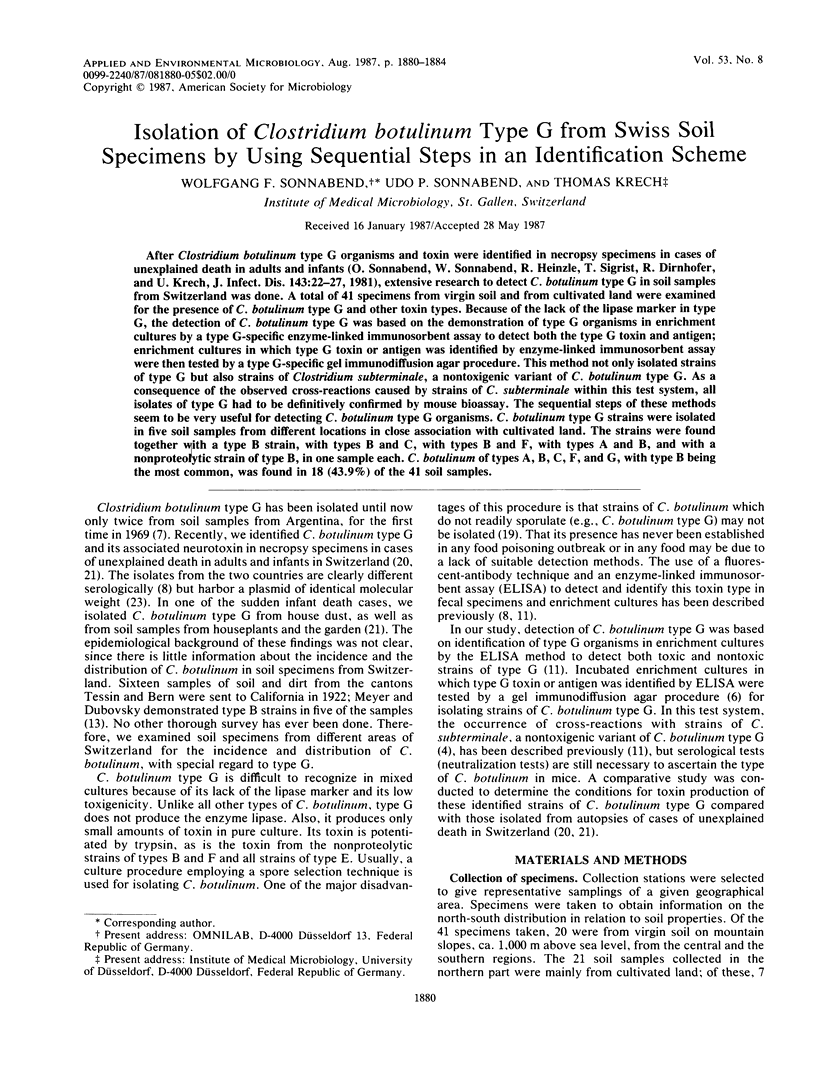
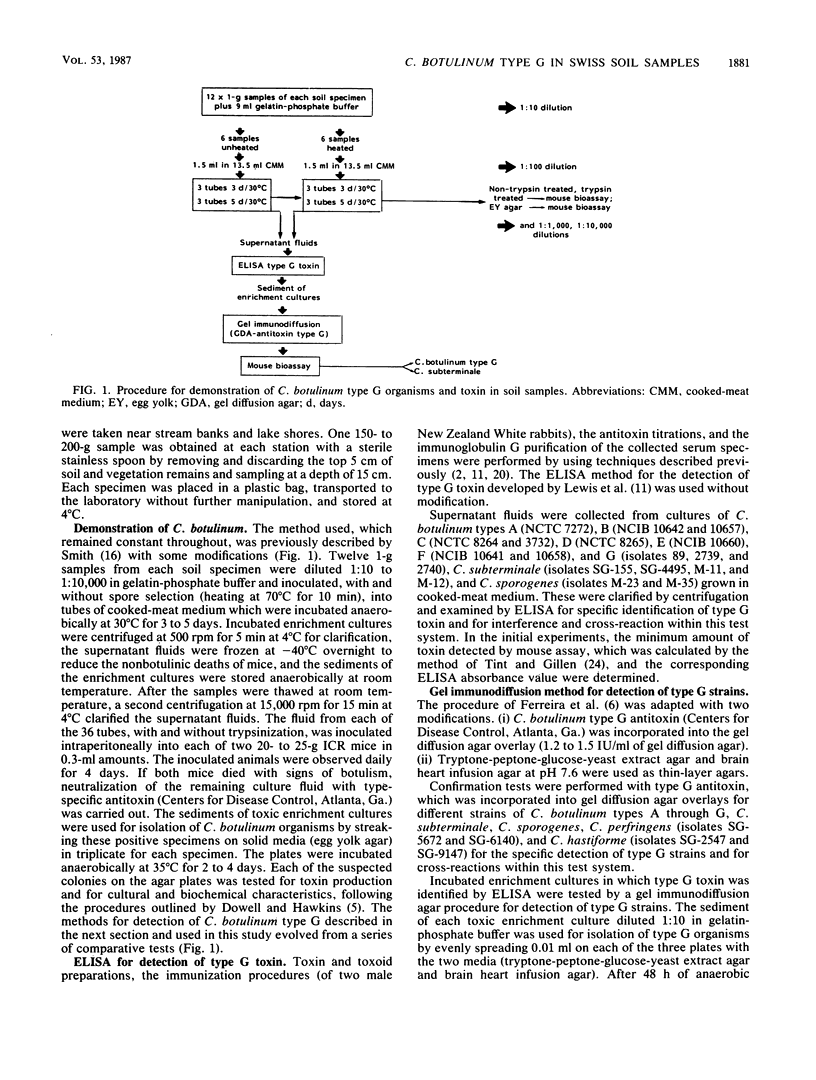
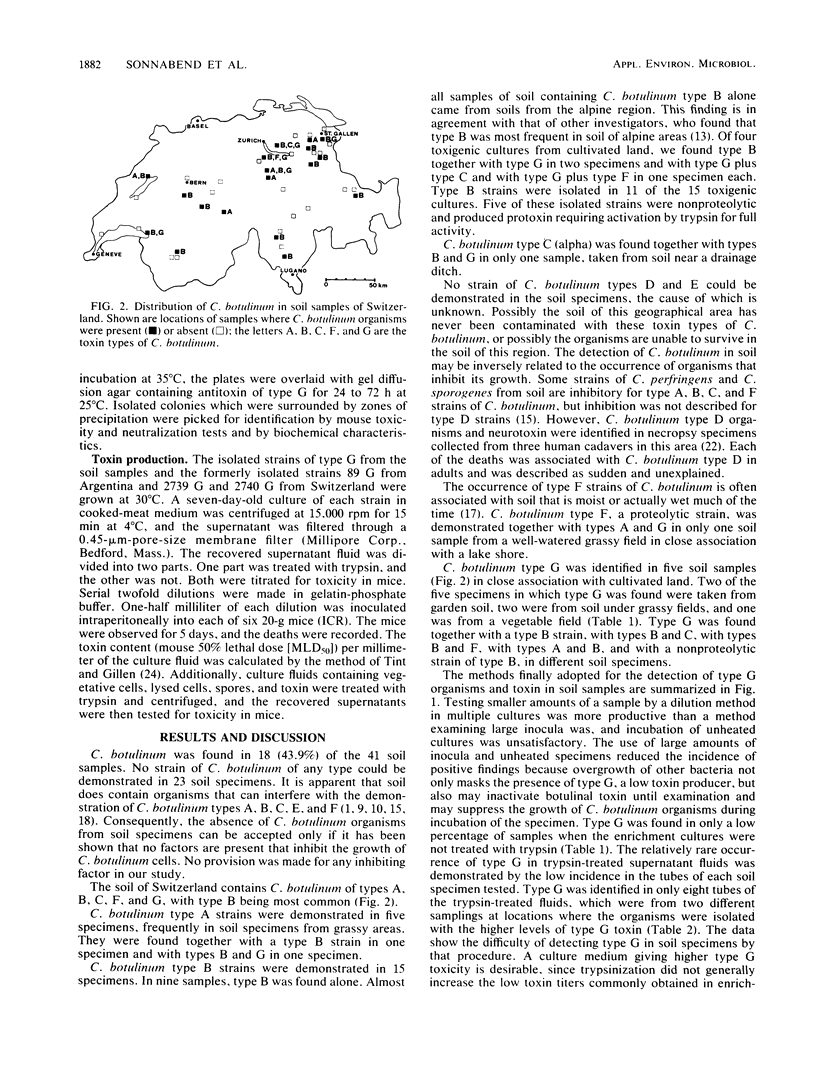
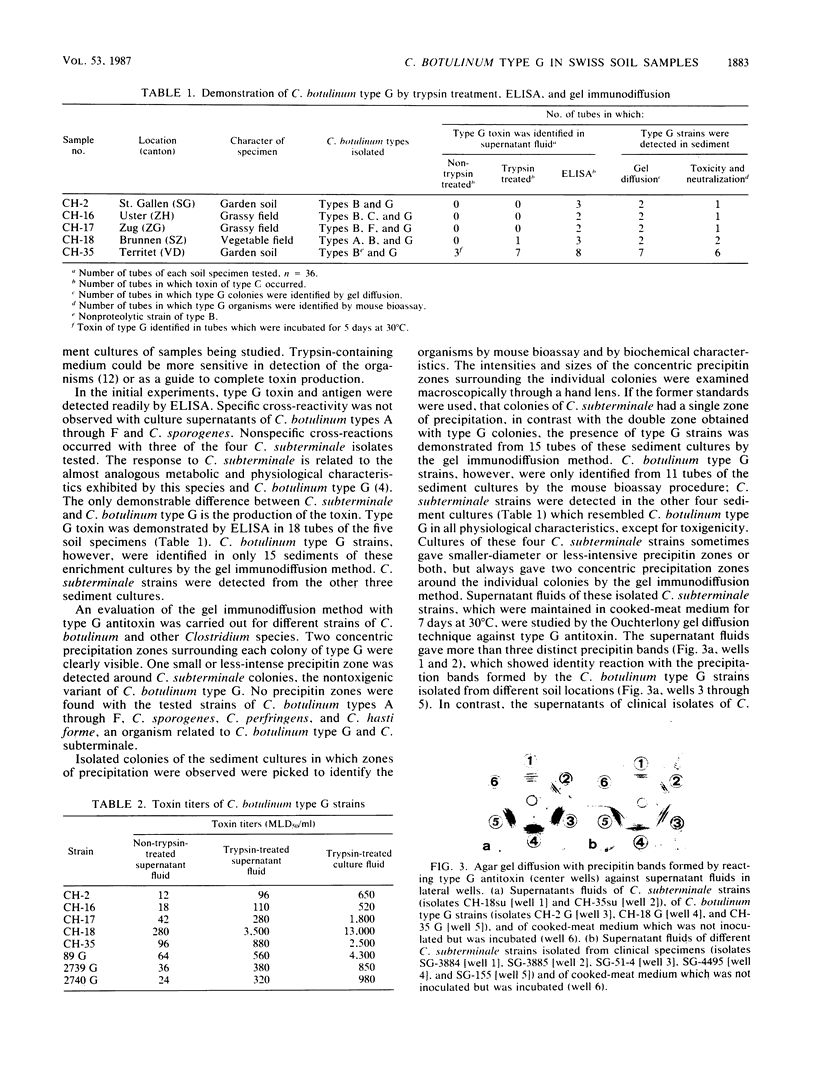
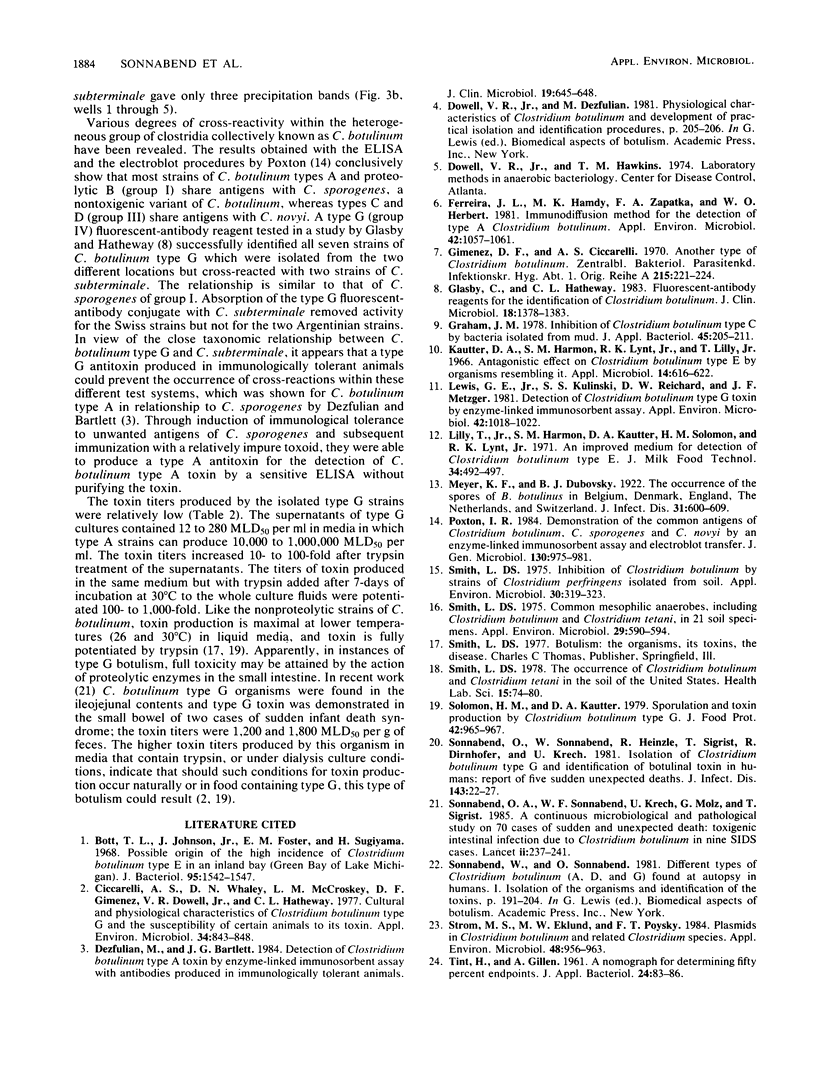
Images in this article
Selected References
These references are in PubMed. This may not be the complete list of references from this article.
- Bott T. L., Johnson J., Jr, Foster E. M., Sugiyama H. Possible origin of the high incidence of Clostridium botulinum type E in an inland bay (Green Bay of Lake Michigan). J Bacteriol. 1968 May;95(5):1542–1547. doi: 10.1128/jb.95.5.1542-1547.1968. [DOI] [PMC free article] [PubMed] [Google Scholar]
- Ciccarelli A. S., Whaley D. N., McCroskey L. M., Gimenez D. F., Dowell V. R., Jr, Hatheway C. L. Cultural and physiological characteristics of Clostridium botulinum type G and the susceptibility of certain animals to its toxin. Appl Environ Microbiol. 1977 Dec;34(6):843–848. doi: 10.1128/aem.34.6.843-848.1977. [DOI] [PMC free article] [PubMed] [Google Scholar]
- Dezfulian M., Bartlett J. G. Detection of Clostridium botulinum type A toxin by enzyme-linked immunosorbent assay with antibodies produced in immunologically tolerant animals. J Clin Microbiol. 1984 May;19(5):645–648. doi: 10.1128/jcm.19.5.645-648.1984. [DOI] [PMC free article] [PubMed] [Google Scholar]
- Ferreira J. L., Hamdy M. K., Zapatka F. A., Hebert W. O. Immunodiffusion method for detection of type A Clostridium botulinum. Appl Environ Microbiol. 1981 Dec;42(6):1057–1061. doi: 10.1128/aem.42.6.1057-1061.1981. [DOI] [PMC free article] [PubMed] [Google Scholar]
- Giménez D. F., Ciccarelli A. S. Another type of Clostridium botulinum. Zentralbl Bakteriol Orig. 1970;215(2):221–224. [PubMed] [Google Scholar]
- Glasby C., Hatheway C. L. Fluorescent-antibody reagents for the identification of Clostridium botulinum. J Clin Microbiol. 1983 Dec;18(6):1378–1383. doi: 10.1128/jcm.18.6.1378-1383.1983. [DOI] [PMC free article] [PubMed] [Google Scholar]
- Graham J. M. Inhibition of Clostridium botulinum type C by bacteria isolated from mud. J Appl Bacteriol. 1978 Oct;45(2):205–211. doi: 10.1111/j.1365-2672.1978.tb04215.x. [DOI] [PubMed] [Google Scholar]
- Kautter D. A., Harmon S. M., Lynt R. K., Jr, Lilly T., Jr Antagonistic effect on Clostridium botulinum type E by organisms resembling it. Appl Microbiol. 1966 Jul;14(4):616–622. doi: 10.1128/am.14.4.616-622.1966. [DOI] [PMC free article] [PubMed] [Google Scholar]
- Lewis G. E., Jr, Kulinski S. S., Reichard D. W., Metzger J. F. Detection of Clostridium botulinum type G toxin by enzyme-linked immunosorbent assay. Appl Environ Microbiol. 1981 Dec;42(6):1018–1022. doi: 10.1128/aem.42.6.1018-1022.1981. [DOI] [PMC free article] [PubMed] [Google Scholar]
- Poxton I. R. Demonstration of the common antigens of Clostridium botulinum, C. sporogenes and C. novyi by an enzyme-linked immunosorbent assay and electroblot transfer. J Gen Microbiol. 1984 Apr;130(4):975–981. doi: 10.1099/00221287-130-4-975. [DOI] [PubMed] [Google Scholar]
- Sonnabend O. A., Sonnabend W. F., Krech U., Molz G., Sigrist T. Continuous microbiological and pathological study of 70 sudden and unexpected infant deaths: toxigenic intestinal clostridium botulinum infection in 9 cases of sudden infant death syndrome. Lancet. 1985 Feb 2;1(8423):237–241. doi: 10.1016/s0140-6736(85)91025-6. [DOI] [PubMed] [Google Scholar]
- Sonnabend O., Sonnabend W., Heinzle R., Sigrist T., Dirnhofer R., Krech U. Isolation of Clostridium botulinum type G and identification of type G botulinal toxin in humans: report of five sudden unexpected deaths. J Infect Dis. 1981 Jan;143(1):22–27. doi: 10.1093/infdis/143.1.22. [DOI] [PubMed] [Google Scholar]
- Strom M. S., Eklund M. W., Poysky F. T. Plasmids in Clostridium botulinum and related Clostridium species. Appl Environ Microbiol. 1984 Nov;48(5):956–963. doi: 10.1128/aem.48.5.956-963.1984. [DOI] [PMC free article] [PubMed] [Google Scholar]



